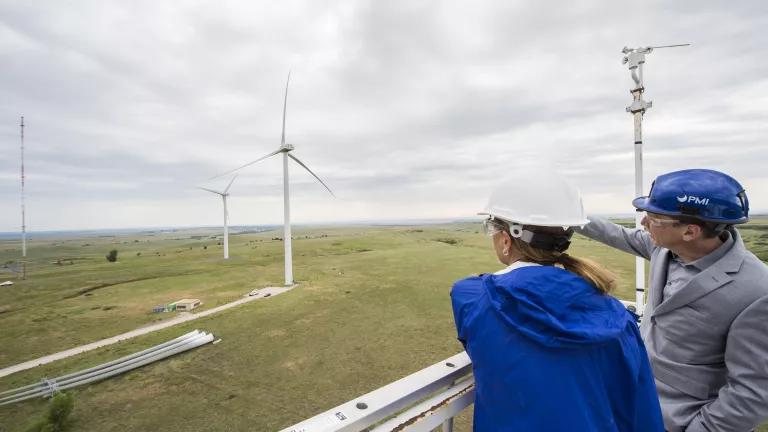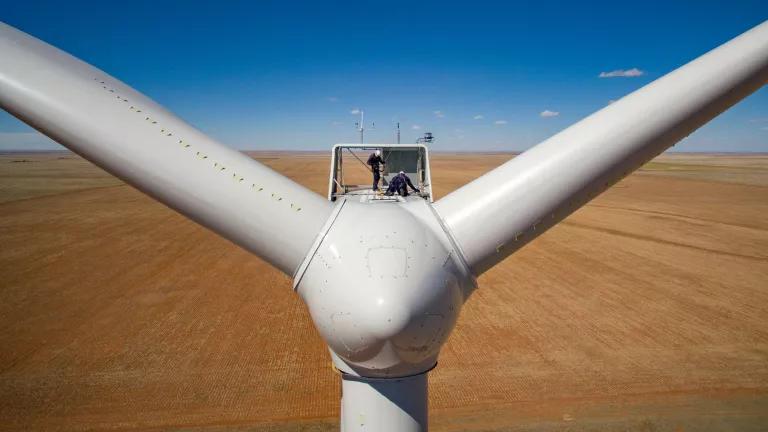Mapping Clean Energy in the West
Colorado and New Mexico can take advantage of Energy Community tax credits to build renewable energy and jumpstart an equitable workforce transition.

National Wind Technology Center (NWTC) Director Daniel Laird points out features of the NWTC from the top of the CART 3 wind turbine
The Southwest has an enormous opportunity to accelerate the shift from fossil to clean power. Utilities in the region can use new tax credit adders that will make clean energy like wind and solar more affordable than ever before, especially in historically underserved communities whose workforce relies on extracting and burning fossil fuels. State administrations and utility commissions should ensure that the transition to clean economies happens right away.
Tax credits from the Inflation Reduction Act make clean energy projects more feasible than ever. The Energy Community Tax Credit Bonus aims to revitalize the economies of coal-powered communities by providing a 10 percent bonus on top of Production Tax Credits and Investment Tax Credits for clean energy projects. To access the bonus, “energy communities” must meet at least one of three criteria: they must be a “brownfield site,” which means that there are affected by hazardous pollutants; they must have had a coal mine close since 1999 or coal plant closure any time since 2009; or they must have a high unemployment rate or at least 0.17 percent of the community employed in the fossil fuels sector.
Together, the three tax credits add up to 3.05 ¢/kWh or up to 50 percent of project cost for clean energy projects, like wind and solar, located in energy communities. This is a significant discount that utilities and project developers should take advantage of to avoid the worst impacts from the climate crisis. The intent of the energy community bonus is to diversify and stimulate the economies that rely on fossil fuels or have experienced environmental harm, which are predominantly low-income communities. The tax credit bonus specifically emphasizes workforce development and employment in clean energy projects, so Colorado and New Mexico can support a workforce transition from fossil to clean energy projects.
The West Is Ready for Clean Energy
Where are these energy communities located? This map shows the energy communities in Colorado and New Mexico. Almost all census tracts in the states qualify as energy communities. In the map below, all blue areas are qualified energy communities. Currently operating coal plants are represented by yellow circles, sized by annual CO2 emissions.

Energy Communities, as defined by the Inflation Reduction Act, and currently-operating coal plants.
Geospatial Data: U.S. Department of Energy, National Energy Technology Laboratory (2023).
In the next map, energy communities are colored by household income. We can see that most energy communities in Colorado and New Mexico have median household incomes between $32,750 and $69,353, on the lower end of the spectrum. Clean energy projects will diversify the economies of these communities and provide employment opportunities to residents.

Energy Communities, Coal plants, and median household income in Colorado and New Mexico.
Geospatial data: U.S. Department of Energy, National Energy Technology Laboratory (2023). Income data: U.S. Census Bureau (2023).
These communities are ready to take advantage of federal tax credits and transition away from dirty energy. As we can see below from analysis by the National Renewable Energy Laboratory, Colorado and New Mexico have among the highest technical potential for renewable electricity in the entire country.

Lopez et al, “U.S. Renewable Energy Technical Potentials: A GIS-Based Analysis,” National Renewable Energy Laboratory, July 2012.

Lopez et al, “U.S. Renewable Energy Technical Potentials: A GIS-Based Analysis,” National Renewable Energy Laboratory, July 2012.

Lopez et al, “U.S. Renewable Energy Technical Potentials: A GIS-Based Analysis,” National Renewable Energy Laboratory, July 2012.
It’s clear that Colorado and New Mexico are ready for clean energy. Renewable development will benefit the economies of energy communities while promoting a fossil fuel-free energy system.
Case Study: The Four Corners Plant
If we zoom in to the Four Corners coal plant in northwest New Mexico, we can see how the Energy Community tax credit bonus could be leveraged for an earlier retirement and a myriad of environmental and economic benefits to the surrounding Navajo community.

The Four Corners Power Plant located in Northwest New Mexico.
Terry Eiler, Public domain, via Wikimedia Commons
The Four Corners plant, owned in part by Public Service Company of New Mexico (PNM), among other utilities, is one of the most polluting coal plants in the West. Located on Navajo Nation, the plant spews 11 million tons of CO2 annually, along with a host of toxic air pollutants that are poisonous to human health, including SO2, NOx, mercury, lead, and arsenic. These pollutants are toxic, and can cause respiratory and cardiovascular disease, cancer, reproductive problems, systemic inflammation, and neurodegeneration, according to research published in Energy Geoscience. The coal for the Four Corners plant is also sourced from a mine within the Navajo Nation, which leaks methane into the atmosphere (an eight times more potent greenhouse gas than carbon dioxide) and toxic pollutants into the San Juan river and produces millions of tons of waste, according to the San Juan Citizens Alliance. Although the plant powers large cities like Las Vegas and Phoenix, over 15,000 members of the Navajo Nation still lack access to electricity.
Four Corners is set to retire in 2031 . But, by harnessing the Energy Community tax credit, this retirement date could be accelerated, saving customers in the region millions of dollars and preventing more toxic pollutants from impacting the community. Navajo tribal members currently make up 80 percent of the workforce at the plant. Retiring Four Corners early would provide immeasurable environmental and health benefits, and, with the Energy Community tax credit, it could also make way for new renewable energy development. This development would provide stable jobs for a transitioning workforce in the Navajo Nation, which already faces disproportionate pollution burdens and lower incomes.
New renewable projects are already cheaper than coal. With these federal tax credits, coal plant closure dates could be accelerated, and the transition to abundant renewable resources can begin in earnest. Energy communities in Colorado and New Mexico deserve to be free from toxic pollution created by fossil fuels. New tax credit adders create an enormous incentive for locating projects in overburdened communities–creating local jobs and revitalizing the economy.
Clean energy development can spur economic development in the communities that need it the most. There is no reason to delay – the West is ready for clean energy, now. States like Colorado and New Mexico should take full advantage of new federal clean energy tax credits.




